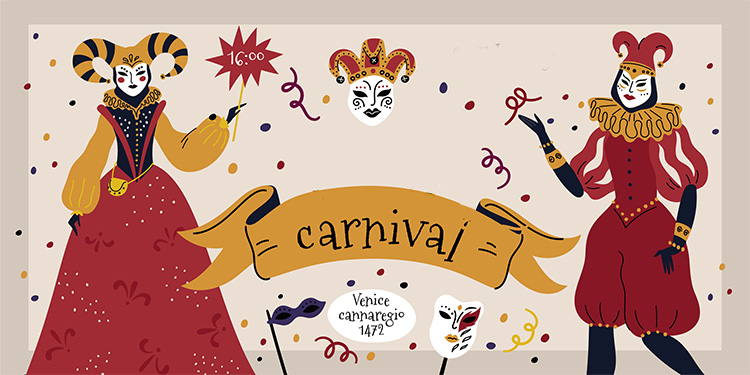
"Fat Tuesday" Traditions
Miscellaneous | Diversity & Inclusion
Mardi Gras, the French phrase for Fat Tuesday, is a celebration most of us associate with New Orleans. While Mardi Gras technically refers to only Fat Tuesday, most years the festivities happen over a two-week period of time, at least here in the U.S. And there’s much more to the tradition than parades, unusual foods, and alcoholic beverages.
It's interesting to note that the U.S. isn’t the only country to celebrate Mardi Gras, also referred to as Carnival season. The tradition extends far beyond the U.S. and the state of Louisiana. Countries ranging from the Czech Republic to Italy and Sweden have their own ways of enjoying Fat Tuesday.
Let’s take a look at the history of Mardi Gras in the United States, along with the traditions that countries around the world have for celebrating.
The Origins of Mardi Gras
The roots of Mardi Gras go back thousands of years to the pagan celebrations of spring and fertility in medieval Europe. When Christianity first came to Italy, religious leaders decided to combine these pagan celebrations into the new faith. The result was a Carnival season where excesses were a prelude to Lent, the 40 days of fasting that span from Ash Wednesday to Easter Sunday.
As Christianity spread, so too did these celebrations. They moved from Rome and Venice to France, Germany, Spain, England, and eventually to the United States. While the intent of Mardi Gras is generally the same from one country to another, the festivities and activities differ.
Fat Tuesday in the United States
In the United States, the history of Fat Tuesday and the events leading up to it date back to 1699. Different French settlements in and around New Orleans hosted various types of activities, ranging from street parties to costume balls with extravagant dinners.
When the Spaniards took over New Orleans in 1793, however, they put an end to Mardi Gras events. That ban would hold for nearly four decades. Once the French regained the state, and sold it to the U.S. in an agreement that would be known as the Louisiana Purchase, things began to change. The celebrations slowly started to reemerge around the year 1827. While Louisiana is the only state to consider Fat Tuesday a legal holiday, Mississippi and Alabama also have festivities of their own today.
The dates for Mardi Gras are linked to Easter, and typically occur in February or early March. In New Orleans, the celebration usually spans from Twelfth Night, the last night of Christmas and the start of Epiphany, to Ash Wednesday.
If you are planning a trip to New Orleans to enjoy Mardi Gras, here are a few tips to keep in mind:
- The colors of the season stay the same from year to year: purple, gold, and green. Keep that in mind when you are planning your outfits or costume
 Also, remember that magnificent masks are very much a part of the Carnival tradition. It started as a way to escape and have fun without being judged for doing so. Now float riders are even required, by law, to wear masks!
Also, remember that magnificent masks are very much a part of the Carnival tradition. It started as a way to escape and have fun without being judged for doing so. Now float riders are even required, by law, to wear masks! - Don’t forget to bring a bag to haul your goodies home. Part of the fun is catching all the bead necklaces and trinkets thrown from floats and balconies.
Carnival Season Abroad
Wondering what Fat Tuesday looks like around the world? Here’s a look at the merriment that takes place in a few other countries:
- If we head to the United Kingdom, what we know as Fat Tuesday is called Shrove Tuesday or Pancake Day. It’s a way to overindulge in sweet treats before Lent begins.
- People in Brazil participate in Carnival festivities that combine European, African, and native Brazilian traditions. The street parties of Carnival are held the Friday before Ash Wednesday. Costumes, parades, and drums are common.
- Our friends to the north in Canada get into the spirit, too. Quebec City hosts the Quebec Winter Carnival each year. The ten-day outdoor party includes everything from ice sculptures and decorations to night parades and musical events.

- The Venice Carnevale dates back to the 13th century and draws tourists from all over. While parades and parties are part of the schedule, Venice is most famous for its elaborate masquerade balls.
Celebrating Life at PSL Communities
If you visit a PSL community during Mardi Gras, you’ll likely notice different activities taking place to coincide with this annual occasion. It’s all part of Thrive Wellness, our unique collaboration between residents and team members. The philosophy is designed to encourage everyone in our communities—residents, staff, and families—to live their best life every day.
We invite you to call a PSL community to learn more about Thrive Wellness or to schedule a visit today!
About Presbyterian Senior Living
As the trusted leader in aging services, Presbyterian Senior Living combines over 95 years of experience with innovative approaches to senior communities and services. Across our 27 communities in PA, MD, OH, and DE, we serve over 6,500 seniors. We are committed to: FOSTERING teamwork and responsibility. UPHOLDING integrity in every action. EMBRACING innovation to create opportunities for everyone’s success. LEADING with compassion and respect.


